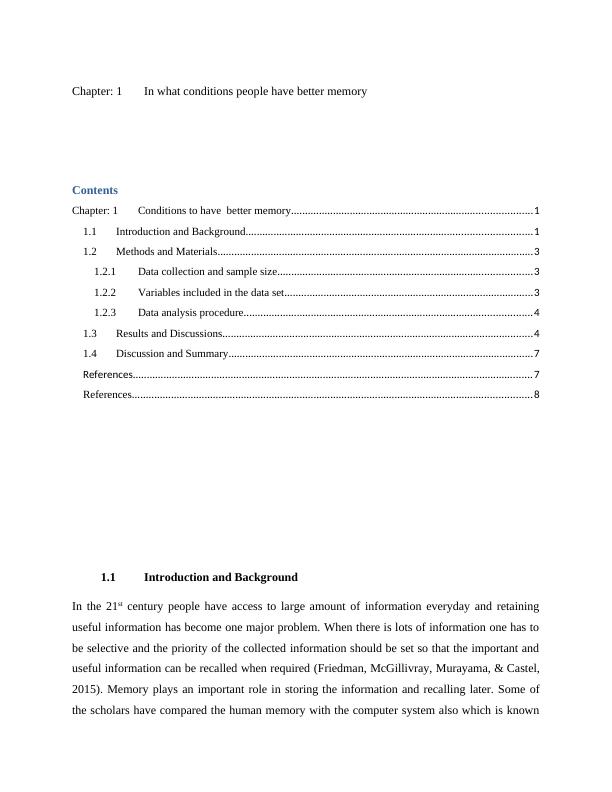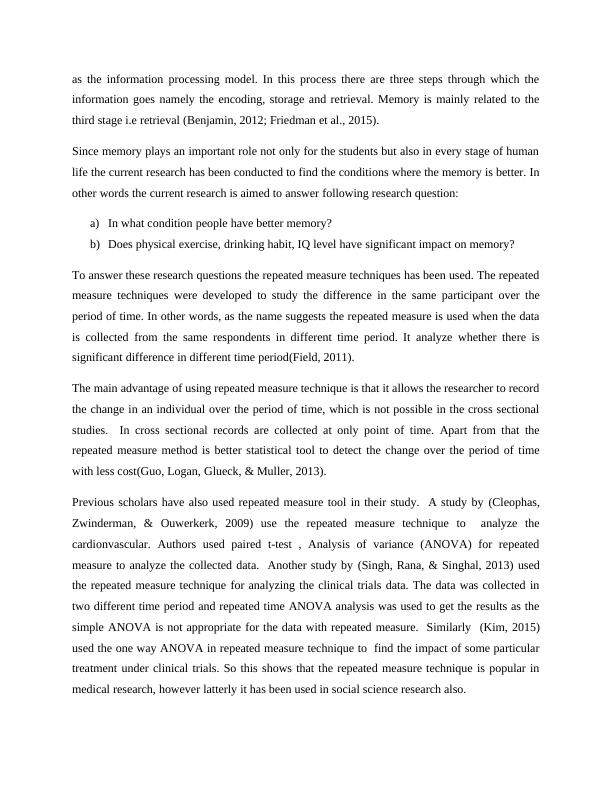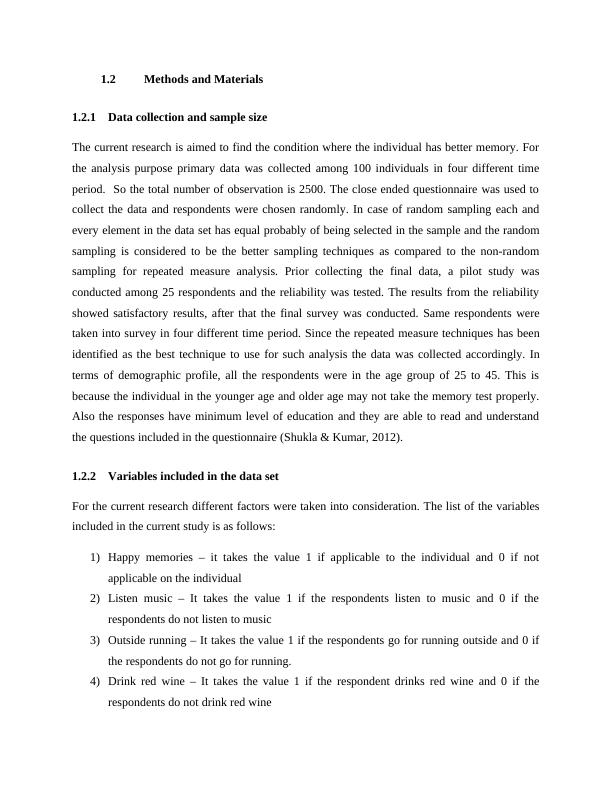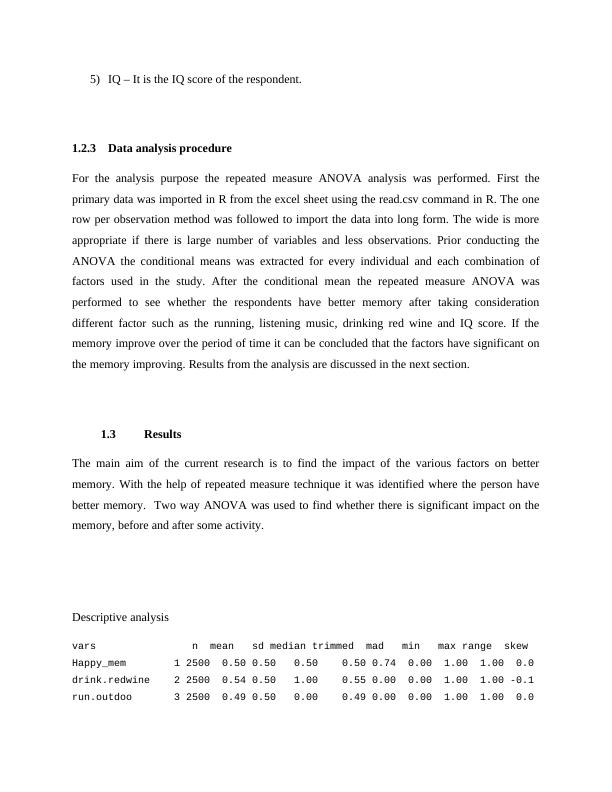Conditions to Have Better Memory
Added on 2020-04-21
11 Pages3127 Words241 Views
Chapter: 1In what conditions people have better memory ContentsChapter: 1Conditions to have better memory......................................................................................11.1Introduction and Background......................................................................................................11.2Methods and Materials.................................................................................................................31.2.1Data collection and sample size...........................................................................................31.2.2Variables included in the data set.........................................................................................31.2.3Data analysis procedure.......................................................................................................41.3Results and Discussions...............................................................................................................41.4Discussion and Summary.............................................................................................................7References...............................................................................................................................................7References...............................................................................................................................................81.1Introduction and Background In the 21st century people have access to large amount of information everyday and retaininguseful information has become one major problem. When there is lots of information one has tobe selective and the priority of the collected information should be set so that the important anduseful information can be recalled when required (Friedman, McGillivray, Murayama, & Castel,2015). Memory plays an important role in storing the information and recalling later. Some ofthe scholars have compared the human memory with the computer system also which is known

as the information processing model. In this process there are three steps through which theinformation goes namely the encoding, storage and retrieval. Memory is mainly related to thethird stage i.e retrieval (Benjamin, 2012; Friedman et al., 2015).Since memory plays an important role not only for the students but also in every stage of humanlife the current research has been conducted to find the conditions where the memory is better. Inother words the current research is aimed to answer following research question:a)In what condition people have better memory?b)Does physical exercise, drinking habit, IQ level have significant impact on memory?To answer these research questions the repeated measure techniques has been used. The repeatedmeasure techniques were developed to study the difference in the same participant over theperiod of time. In other words, as the name suggests the repeated measure is used when the datais collected from the same respondents in different time period. It analyze whether there issignificant difference in different time period(Field, 2011).The main advantage of using repeated measure technique is that it allows the researcher to recordthe change in an individual over the period of time, which is not possible in the cross sectionalstudies. In cross sectional records are collected at only point of time. Apart from that therepeated measure method is better statistical tool to detect the change over the period of timewith less cost(Guo, Logan, Glueck, & Muller, 2013).Previous scholars have also used repeated measure tool in their study. A study by (Cleophas,Zwinderman, & Ouwerkerk, 2009) use the repeated measure technique to analyze thecardionvascular. Authors used paired t-test , Analysis of variance (ANOVA) for repeatedmeasure to analyze the collected data. Another study by (Singh, Rana, & Singhal, 2013) usedthe repeated measure technique for analyzing the clinical trials data. The data was collected intwo different time period and repeated time ANOVA analysis was used to get the results as thesimple ANOVA is not appropriate for the data with repeated measure. Similarly (Kim, 2015)used the one way ANOVA in repeated measure technique to find the impact of some particulartreatment under clinical trials. So this shows that the repeated measure technique is popular inmedical research, however latterly it has been used in social science research also.

1.2Methods and Materials 1.2.1Data collection and sample sizeThe current research is aimed to find the condition where the individual has better memory. Forthe analysis purpose primary data was collected among 100 individuals in four different timeperiod. So the total number of observation is 2500. The close ended questionnaire was used tocollect the data and respondents were chosen randomly. In case of random sampling each andevery element in the data set has equal probably of being selected in the sample and the randomsampling is considered to be the better sampling techniques as compared to the non-randomsampling for repeated measure analysis. Prior collecting the final data, a pilot study wasconducted among 25 respondents and the reliability was tested. The results from the reliabilityshowed satisfactory results, after that the final survey was conducted. Same respondents weretaken into survey in four different time period. Since the repeated measure techniques has beenidentified as the best technique to use for such analysis the data was collected accordingly. Interms of demographic profile, all the respondents were in the age group of 25 to 45. This isbecause the individual in the younger age and older age may not take the memory test properly.Also the responses have minimum level of education and they are able to read and understandthe questions included in the questionnaire (Shukla & Kumar, 2012). 1.2.2Variables included in the data set For the current research different factors were taken into consideration. The list of the variablesincluded in the current study is as follows:1)Happy memories – it takes the value 1 if applicable to the individual and 0 if notapplicable on the individual 2)Listen music – It takes the value 1 if the respondents listen to music and 0 if therespondents do not listen to music 3)Outside running – It takes the value 1 if the respondents go for running outside and 0 ifthe respondents do not go for running. 4)Drink red wine – It takes the value 1 if the respondent drinks red wine and 0 if therespondents do not drink red wine

5)IQ – It is the IQ score of the respondent. 1.2.3Data analysis procedureFor the analysis purpose the repeated measure ANOVA analysis was performed. First theprimary data was imported in R from the excel sheet using the read.csv command in R. The onerow per observation method was followed to import the data into long form. The wide is moreappropriate if there is large number of variables and less observations. Prior conducting theANOVA the conditional means was extracted for every individual and each combination offactors used in the study. After the conditional mean the repeated measure ANOVA wasperformed to see whether the respondents have better memory after taking considerationdifferent factor such as the running, listening music, drinking red wine and IQ score. If thememory improve over the period of time it can be concluded that the factors have significant onthe memory improving. Results from the analysis are discussed in the next section.1.3Results The main aim of the current research is to find the impact of the various factors on bettermemory. With the help of repeated measure technique it was identified where the person havebetter memory. Two way ANOVA was used to find whether there is significant impact on thememory, before and after some activity. Descriptive analysis vars n mean sd median trimmed mad min max range skewHappy_mem 1 2500 0.50 0.50 0.50 0.50 0.74 0.00 1.00 1.00 0.0drink.redwine 2 2500 0.54 0.50 1.00 0.55 0.00 0.00 1.00 1.00 -0.1run.outdoo 3 2500 0.49 0.50 0.00 0.49 0.00 0.00 1.00 1.00 0.0

End of preview
Want to access all the pages? Upload your documents or become a member.
Related Documents
Effectiveness of Self-Testinglg...
|7
|1702
|122
Effect of Retrieval Cues on Memory Recalllg...
|18
|3649
|68
Journey of a Human Retentionlg...
|12
|2488
|478
The length of the memory spanlg...
|13
|3100
|13
False Memories and Repercussionlg...
|19
|5251
|80
Research Methodology in Psychologylg...
|8
|2420
|363
